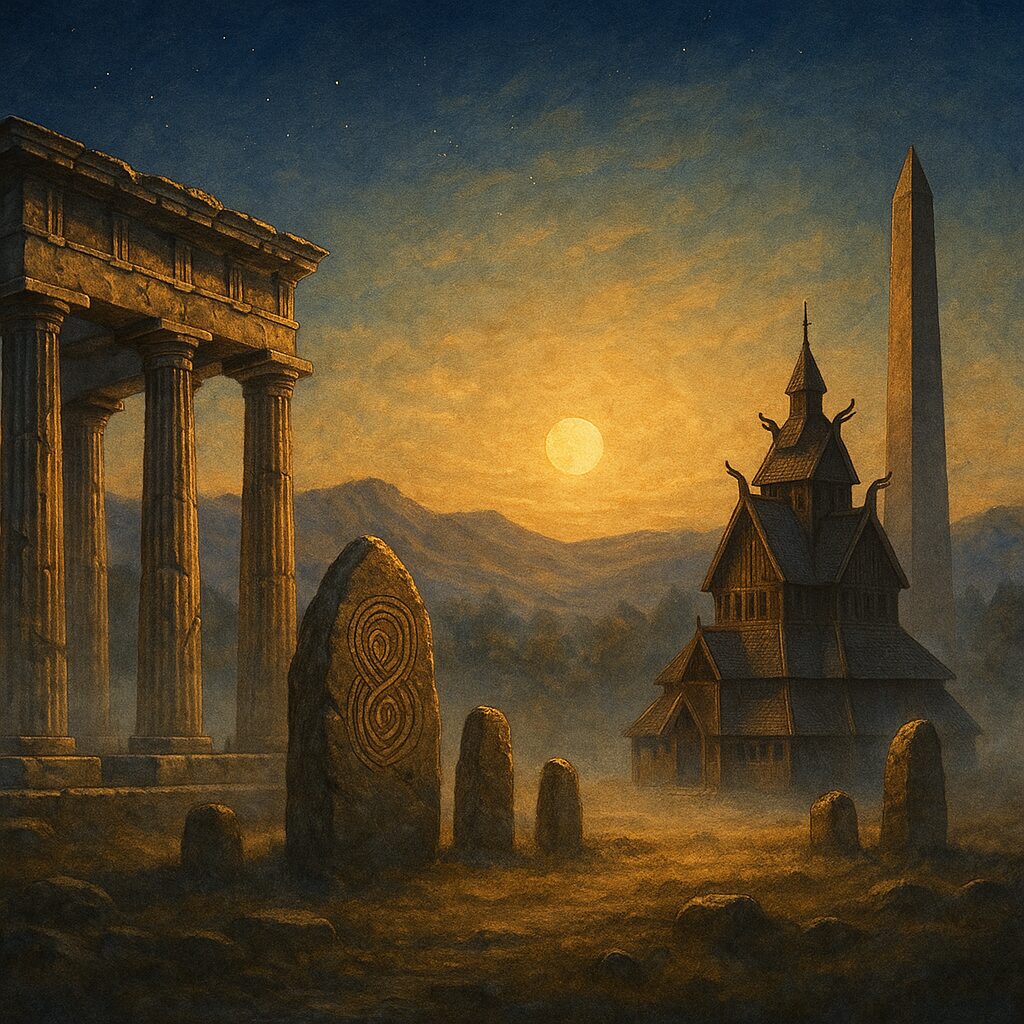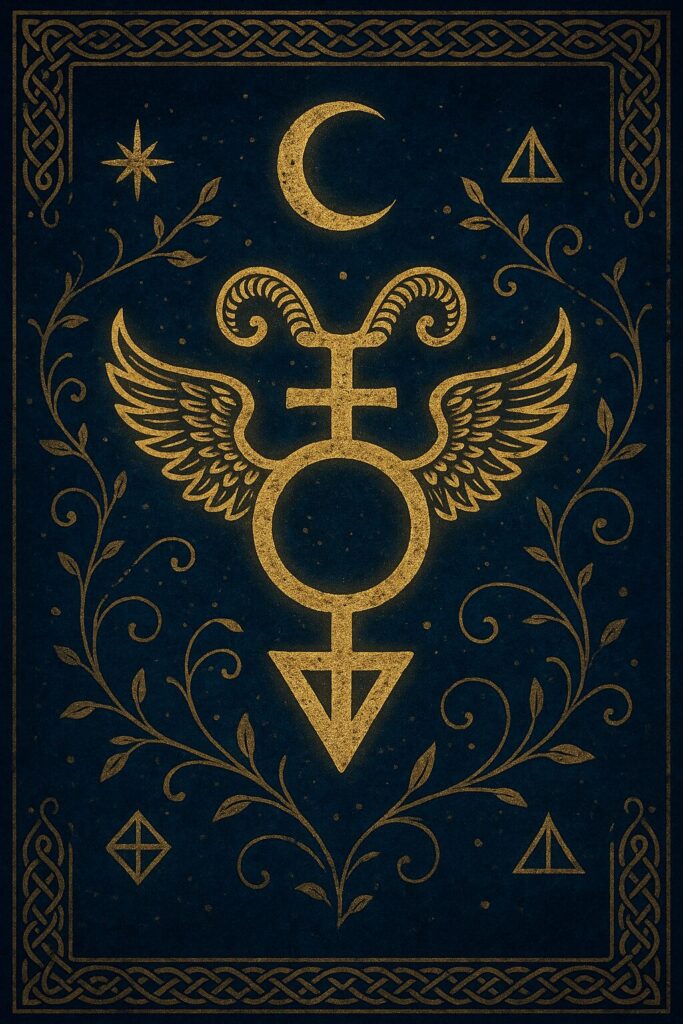Reconstructed and Revivalist Paths

Over recent decades, there has been a quiet yet undeniable resurgence of pre-Christian and polytheistic faiths. This movement is more than nostalgia for lost gods; it is a response to the spiritual narrowing that many feel in the modern age. Monotheistic traditions—especially in their more authoritarian or exclusionary forms—have offered grandeur, discipline, and moral clarity, yet they have too often demanded obedience at the cost of diversity. In declaring that there is but one way, one truth, one god, such systems have sometimes othered all who see the sacred differently. The impulse to forsake “false gods” carries an unintended admission: that there are, indeed, other gods to forsake.
Not all forms of monotheism are oppressive or controlling—many remain profound vessels for compassion and community—but for countless seekers, the single, jealous voice of heaven has felt insufficient to express the chorus of a plural world. As cultures intertwine and identities multiply, the insistence on a solitary divine narrative begins to ring hollow. In its place arises a longing for what came before: religions woven of reciprocity rather than dominance, where divinity is mirrored through many faces and found not in abstraction but in the pulse of the earth, the seasons, and the ancestral hearth.
Those drawn to reconstruction and revival do not simply invent new creeds. They engage in acts of remembrance: reading old tongues, studying temple fragments, tracing forgotten festivals through folklore and song. These practitioners seek to re-inhabit rather than merely reinterpret. Their work is both scholarship and devotion, re-weaving broken threads of lineage, land, and language until the gods and spirits are again present, not as museum relics but as living powers.
Common among these revivals is a desire for reciprocity—a living relationship between deity, land, and tradition. They share an understanding that the sacred is not only transcendent but embodied, dwelling in offerings, in seasons, in the rhythms of household and community. Ethics and piety are intertwined: right relationship becomes right action. Rather than metaphysical speculation detached from life, these ways root divinity in soil, fire, and breath.
Many reconstructed paths also intersect with witchcraft, folk magic, and Wicca. They meet in shared gestures: the pouring of wine, the lighting of candles, the whisper of a name to the wind. Some remain purely devotional, while others blur the line between priest, scholar, and witch—restoring the ancient continuum between craft and cult. Each is a distinct thread in the larger tapestry of living polytheism, reaching back through time not to escape the modern world, but to remind it that the sacred has always been plural, embodied, and near at hand.
Reconstructed & Revivalist Paths
| Tradition / Path | Region of Origin | Major Festivals / Observances | Overlap with Witchcraft / Wicca | Major Groups / Resources |
|---|---|---|---|---|
| Hellenic Polytheism (Hellenismos) | Ancient Greece (Attica, Ionia) | Noumenia Hekate’s Deipnon Anthesteria Thargelia | Moderate: cultic piety is primary; some blend Hermetic/occult elements with care. | Hellenion; LABRYS (Greece) |
| Norse Heathenry / Ásatrú | Scandinavia, Iceland; Germanic Europe | Yule Midsummer Winternights Dísablót | High: seiðr, galdr, and land-wight work overlap with modern witchcraft practice. | The Troth; Ásatrú UK |
| Celtic Reconstructionism | Ireland, Wales, Gaul, Scotland | Imbolc Beltane Lughnasadh Samhain | Medium: shares seasonal rites, herb-lore, and poetic incantation; less eclectic by design. | Pàganachd CR FAQ; OBOD (neo-Druid resource) |
| Slavic Rodnovery / Baltic Romuva | Eastern Europe; Baltics | Kupala Night Perun’s Day Harvest & Ancestor Feasts | Moderate: robust folk-magic and household spirit work parallel witchcraft’s domestic charms. | Romuva North America; Union of Slavic Communities |
| Kemetic (Ancient Egyptian) Reconstruction | Ancient Egypt (Nile Valley) | Wep Ronpet (New Year) Opet Feast of Hathor Daily Temple Rites | Low–moderate: devotional cultus first; heka and ritual tech inform Western magic. | House of Netjer; Kemetic Reform |
| Roman Polytheism (Religio Romana / Cultus Deorum) | Ancient Rome / Italy | Parilia Saturnalia Vestalia Kalends | Low: civic/household cult distinct from witchcraft; ritual precision admired by many. | Nova Roma |
| Mesopotamian / Sumerian-Akkadian Revivals | Mesopotamia (Sumer, Akkad, Babylon) | Akitu (New Year) Monthly/Lunar Offerings | Moderate: incantations, amulets, and ritual texts share roots with ceremonial witchcraft. | ETCSL (Oxford); CDLI |
| Finnic (Suomenusko) Revivals | Finland, Karelia | Kekri (Ancestors) Midsummer Bonfires Hiisi Site Rites | Moderate: trancework and folk-healing overlap with shamanic witchcraft practices. | Karhun kansa; Taivaannaula |
| Canaanite / Levantine Reconstruction | Levant: Ugarit, Phoenicia, Canaan | Seasonal Harvests Spring Fertility Rites Lunar Observances | Low–moderate: intersects more with Hermetic/ceremonial currents than Wicca directly. | Natib Qadish |
|
Shared Traits & Ethics:
Scholarship-as-devotion
Language & lore revival
Household & civic piety
Seasonal reciprocity
Clear sourcing & transparency
Consentful cultural borrowing
Land & ancestor reverence
Ethic as sacred duty
These are living traditions, not museum pieces. Where you innovate or blend with witchcraft/Wicca, note it openly;
prefer primary sources and reputable community groups; and keep reciprocity, consent, and cultural integrity at the center of practice.
|
||||
⚖️ Hellenic Polytheism (Hellenismos)▶
Where & When: Rooted in ancient Greece—from the city cults of Attica to Ionian and island traditions—Hellenismos is reconstructed from classical literature, inscriptions, and archaeology. Modern communities adapt civic calendars and household rites to contemporary life while maintaining authentic ritual structure.
What It’s About: Central is eusebeia (piety) expressed through offerings, hymns, libations, and festival observance — Noumenia, Hekate’s Deipnon, Anthesteria, Thargelia. Relationships with Olympian, chthonic, and hero cults are reciprocal and ordered by xenia (sacred hospitality).
Balance civic precedent with personal devotion; distinguish historical theurgy from modern Hermeticism; preserve the diversity of local cults rather than merging them into one generalized “Greek faith.”
🪓 Norse Heathenry / Ásatrú▶
Where & When: Scandinavia and the broader Germanic world, drawing on the Eddas, sagas, and archaeology. Modern kindreds rebuild communal rites in new landscapes while honoring local land-wights and ancestors.
What It’s About: Blót (offering) and sumbel (toasting) maintain frith (harmony) between gods, people, and ancestors. Core virtues include honor, kinship, and reciprocity. Seiðr, galdr, and rune-work bridge ritual and magic for some practitioners.
Inclusive Heathenry rests on community and responsibility, not bloodline; trance and runes benefit from ethical discipline and historical context; the lore is a mirror for modern values, not an excuse for old prejudice.
☘️ Celtic Reconstructionism▶
Where & When: Gaelic and Brythonic lands — Ireland, Wales, Scotland, and ancient Gaul — rebuilt from saga cycles, bardic poetry, and place-lore. Language revival (Irish, Welsh, Gaulish) itself acts as devotion.
What It’s About: Honoring the Tuatha Dé Danann, the land-spirits, and the ancestors through seasonal rites (Imbolc, Beltane, Lughnasadh, Samhain). Poetry and herb-lore serve as magical arts within a ritual worldview that values sovereignty and reciprocity with the land.
Regional difference matters—Gaelic and Brythonic streams carry unique cosmologies. Root practice in living languages and local ecology rather than pan-“Celtic” aesthetic fantasy.
🌾 Slavic Rodnovery & Baltic Romuva▶
Where & When: Eastern Europe and the Baltic states, revived from folklore, song, and seasonal customs. Modern festivals reawaken communal ritual in villages and diaspora settings.
What It’s About: Reverence for household spirits (Domovoi and kin) and deities of sky, soil, and fate. Bonfires, river rites, and chant celebrate cyclical time and ancestral continuity. Folk magic and protective charms remain central to daily spirituality.
Authentic revival depends on community and ethics rather than nationalism. Honoring land and lineage calls for hospitality toward others and awareness of historical pain in the region.
☀️ Kemetic (Egyptian) Reconstructionism▶
Where & When: Ancient Egypt’s temple religion re-imagined for modern devotion, drawing on texts, iconography, and archaeological record across dynasties.
What It’s About: Centering Ma’at (cosmic order) through offerings, purity, and festival cycles (Wep Ronpet, Opet, Feast of Hathor). Service to the Netjeru (Isis, Ra, Anubis, Hathor) sustains balance in creation. Heka — word-magic — informs spell craft without eclipsing devotion.
Distinguish periods and local temple styles; avoid flattening diverse dynastic voices into one. Magic is a by-product of right relationship and truthful speech rather than a shortcut to power.
🏛️ Roman / Italic Polytheism (Religiō Rōmāna)▶
Where & When: Ancient Rome and Italy, from household shrines to public temples. Practice draws on inscriptions, ritual formulae, and the fasti (calendars).
What It’s About: Pietas (duty), precision, and community. Civic and domestic rites honor Jupiter, Vesta, the Lares and Penates. Some use ancient texts on omens and auspices to frame ethical decision making today.
Ritual accuracy reflects ethical clarity; innovation is welcome when acknowledged. Roman piety joins spiritual order with civic responsibility.
🔱 Mesopotamian / Ancient Near Eastern Reconstruction▶
Where & When: Sumer, Akkad, Babylon, Assyria — reconstructed from cuneiform tablets, hymns, and ritual texts. Often practiced as a blend of study and devotion through home shrines.
What It’s About: Honoring Inanna/Ishtar, Marduk, and Sin through offerings and hymns. Rituals observe lunar calendars and use incantations for protection and purification. Amulets and talismanic writing represent one of the oldest recorded forms of ritual magic.
Each city-state had its own pantheon emphasis and liturgical tone; honoring that diversity keeps the practice alive and truthful to its roots.
🐻 Finnic / Sámi Indigenous Revival▶
Where & When: Finland, Karelia, and Sápmi. Traditions documented in folk songs and drum ritual are being revived as living indigenous spiritualities.
What It’s About: Animist kinship with land and spirits; drumming, healing, and vision journeys. Seasonal bonfires and ancestor rites such as Kekri maintain community memory and continuity.
These are not open traditions for appropriation but living cultures seeking respect and mutual support. Right relationship means consent, collaboration, and humility.
🌙 Canaanite / Levantine Reconstruction▶
Where & When: The Levant — Ugarit, Phoenicia, Canaan — informed by tablets, inscriptions, and archaeology. Practitioners adapt agricultural and lunar rituals for modern urban life.
What It’s About: Household and seasonal offerings to Baʿal, Anat, El, and Asherah within a framework of reciprocal covenant. Ethical practice emphasizes right relationship and measured speech. Magical aspects align more with Hermetic traditions than with Wicca.
Precision and context matter: each deity’s cult had its own season, tone, and cosmology. Modern revival thrives when it honors that variety without flattening it into abstraction.
These reconstructed and revivalist paths collectively reflect a profound turn toward rootedness, ritual, reciprocity and the reclamation of ancestral relationships—relationships not only with gods and ancestors, but with land, seasons and community. While each tradition carries its own distinct cosmology, sacral grammar, language, and ritual rubric, they share the commitment to living ritual rather than mere homage, and to ethic as devotion rather than detached metaphysics.
Moreover, the intersections with witch-craft, folk tradition and magic are both inevitable and fruitful: the revivalist paths provide lineages, liturgies, and cosmologies; witch-craft often brings adaptation, improvisation, craft and transformative praxis. For communities such as yours, these paths offer both structure and creative flexibility.
“Modern Paganism consists of a related complex of religions … which are inspired by beliefs and images taken from the religions of pre-Christian Europe and the Near East … The change in the twentieth century was to recombine varying elements of all four and to put the deities back into the mix.”
— Ronald Hutton

